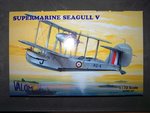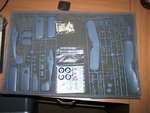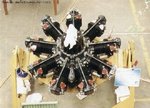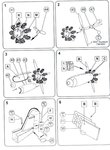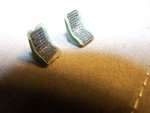parsifal
Colonel
Entry Details
Supermarine Seagull V 101 Fleet Co-operation flight RAAF, aircraft S/N A2-4 (embarked HMAS PERTH 1941
User name: Parsifal
Name: Michael
Category: 1, Beginner
Kit: Valom Kit no 72014
Scale: 1/72.
Accessories: None at this stage
The Supermarine Seagull V was one of the early aircraft taken to sea by the Royal Australian Navy and a "Heavy Hitter" in its influence to establish a viable Fleet Air Arm for the RAN. The story of the aircraft's development, in the Australian context, is an interesting one, and links all the way back to the first Australian Seaplane Carrier, the HMAS Albatross
The RAN first initiated plans for a naval air service in 1913 and, as early as 1917, a move was made to obtain Australia's first aircraft carrier. With the incursion into the Pacific of the German raiders SMS Wolf - with her Friedrichshafen FF33E seaplane Wolfchen (or Wolf Cub) – and Seeadler, the Australian Naval Board requested the loan of a similar carrier to HMS Riviera. The Admiralty replied, however, that this 'was not possible in the circumstances'. In fact, carriers were in such demand at the time that the Royal Navy had taken over an Australian mail steamer, SS Nairana, which was being built in the United Kingdom for the Bass Strait run between Melbourne and Launceston, and converted it into a light aircraft carrier which was commissioned as HMS Nairana in September 1917.
During the same year aircraft of the Royal Naval Air Service began operating aboard Australian warships serving with the RN. HMAS Brisbane first embarked a Sopwith Baby seaplane in mid-1917 and, in December, Sopwith Pups were launched from HMA Ships Sydney and Australia. During 1918 Australia was equipped with a Sopwith 1½ Strutter and a Camel – or, sometimes, two Camels – and Sydney and Melbourne each carried a Camel. When the war ended on November 11 1918, plans for a Royal Australian Naval Air Service were still in abeyance, and the Australian warships returned their aircraft to the Royal Air Force in 1919, before sailing for home waters.
In February 1924 when the British Government informed the Dominions that, for the time being, no further expenditure would be incurred on the Singapore Naval Base. This decision particularly affected the political defence planning of Australia and, as a result, a naval expansion program was immediately initiated, which included the development of a home designed seaplane carrier, the HMAS Albatross (as she was eventually named) . .
Australia's so-called 'seaplane carrier' necessitated much original thought as the design of such a ship had never before been planned from the drawing board stage. The early seaplane carriers of the RN had been improvised versions of ships laid down for other purposes. 'You can say that the hull was designed around three holds, three cranes, and 21 knots,' wrote the designer of Albatross, Constructor Stephen Payne, some years later. Payne had the assistance of a young naval architect, Mr. Woolnough, who was attached to Australia House, London. Woolnough attended the weekly meetings at the Admiralty and, presumably, obtained the necessary information, piecemeal, from Australia as the design progressed.
You may ask why I am spending so much time describing the Albatross. What does this have to do with the Seagull V….a lot as it turns out.
Payne had , ascertained that Albatross would be required to carry a maximum of nine aircraft, although it was uncertain what type of aircraft was nominated. It would appear that the designer assumed that the Fairey IIIDs in Australia were to be the 'seaplane carried'. At any rate, the dimensions of the aircraft deck hatch and hangars provided sufficient space to operate the IIIDs with their wings folded. The cranes also had the capacity to cope with the all-up-weight of the IIIDs. In fact, Janes Fighting Ships, from 1929 to 1934, annually reported that 'at present 6 Fairey machines are carried' aboard Albatross – despite the fact that the last Fairey IIID had been phased out of RAAF service in 1929……The replacement aircraft for the Fairey IIIDs were the Seagull III, ordered in 1925.However with only 6 on hand, this was barely sufficient to meet training requirements, and the replacement for the Albatross remained undetermined as her design progressed. To try and accommodate this uncertainty the freeboard of the Albatross was raised
On Thursday, February 23 1928 –Australia's first aircraft carrier was launched at Cockatoo Island Dockyard. At about that time it was decided that the RAAF would provide the aircraft, pilots, and maintenance personnel for the new carrier, and the RAN the observers and telegraphists. Naval officers, however, could train as pilots for RAAF service if circumstances permitted – although this was also discontinued in the 1930s. In the event the Navy was given operational control of embarked RAAF aircraft, a system that remained in force until 1944.
Albatross took on board the additional aircraft (Seagull IIIs) and personnel of 101 flight (Fleet Co-operation) in February 1929. Almost immediately the ship was involved in the abortive search for Kingsford Smith.
During the tour of PNG in July/August 1929, Albatross embarked the Wackett Widgeon II for tropic trials. At that time, the Chief of the Air Staff, Air Commodore R. Williams, had initiated action to replace the wooden-hulled Seagull IIIs in Albatross. 'I obtained the dimensions of the hangar and the capacity of the crane – anything which affected the handling of aircraft in and out of the ship,' recalls Sir Richard in his memoirs. '. . . with the assistance of my Director of Technical Services, then Wing Commander H. C. Harrison, we drew up a specification of the aircraft we would need.' The resultant specification – an air-cooled metal construction, strengthened for catapulting, fitted with folding wings, with provision for a crew of three, and of such dimensions as to operate from Albatross – was submitted in 1929. This aircraft eventually materialised as the RAAF's Supermarine Type 236 Seagull V of 1933 and, later, the RAF's and FAA's Walrus I of 1935, and wooden-hulled Walrus II of 1941.
The full impact of the Depression bit deep on Australian defence, and on April 23,1933, HMAS Albatross was paid off into the Reserve Fleet. For the next five years the aircraft carrier was either swinging at anchor in Sydney Harbor, or berthed at Garden Island. Ironically, the prototype Supermarine Seagull V – the amphibian specially designed for Albatross to Air Commodore Williams' specification – took to the air for the first time on June 21 1933, two months after Albatross was laid up.
Early in 1936 an E III H catapult was fitted to Albatross at Garden Island, in anticipation of the carrier being recommissioned by the time the first of the 24 Seagull Vs had arrived in Australia. But it was not to be. Catapult trials were carried out with a Seagull V in August 1936, however Albatross remained in reserve until April 19 1938, when she was accepted by the Admiralty as part payment for the new cruiser, HMAS Hobart; as from 1936 all the RAN cruisers – Australia, Canberra, Sydney, Hobart and Perth were equipped with their own Seagull V amphibian, thus negating the requirement for Albatross.
Although the genesis of naval air power in Australia is closely associated with the RAN's first aircraft carrier, the warship was almost forgotten by the nation she served. That is until August 31 1948, when the Naval Air Station at Nowra, NSW, was commissioned as HMAS Albatross. RANAS Nowra is the shore support base for the RAN FAA, and it is most appropriate that the station perpetuates the name HMAS Albatross – the first of the line
Albatross went on to fight a successful war for the RN, but passed from the Australian experience. However, the aircraft desgned to embark on her were to prove highly successful and eventually were adopted across the RN as their main shipboard seaplane
24 Seagull Vs were ordered by the RAAF prewar and were delivered 1936-8. A further 13 slightly modified Walrus Is were delivered during the war.. Tough but slow, these seaplanes performed a wide variety of different tasdks, and like so many aircraft, were unsung workhorses. Seagulls were capable of flying in most weather conditions, and well suited to their spotter, reconnaissance and rescue roles. They were also used in ASW patrols, sinking at least five enemy submarines. Aircraft A2-4, whilst embarked on HMAS Hobart in 1941 bombed the Italians in Somalia, destroying two trucks and killing at least 19 men in strafing runs. Till the end of the war, however, the RAN possessed no independent air arm.. During the difficult years of W.W.II, in Europe and the Pacific, the RAAF pilots and personnel worked hard to assist the RAN through their fleet co-operation units, 101, 9 and 5 Squadrons.
When the Second World War erupted in October 1939, Seagull V amphibians were embarked on the cruisers HMAS Australia, Canberra, Hobart, Sydney and later Perth, along with the armed merchant cruisers HMAS Manoora and Westralia. During W.W.II RAN ships were engaged in operations against the enemy as far afield as the North, West and South Atlantic, the Caribbean, the Mediterranean, the Indian Ocean, Persian Gulf, the Red Sea, South East Asia, the Pacific, and home waters. During this time the RAN Seagull V and Walruses were engaged in scouting patrols, reconnaissance, spotting for the cruiser's guns, as well as bombing enemy targets.
Supermarine Seagull V 101 Fleet Co-operation flight RAAF, aircraft S/N A2-4 (embarked HMAS PERTH 1941
User name: Parsifal
Name: Michael
Category: 1, Beginner
Kit: Valom Kit no 72014
Scale: 1/72.
Accessories: None at this stage
The Supermarine Seagull V was one of the early aircraft taken to sea by the Royal Australian Navy and a "Heavy Hitter" in its influence to establish a viable Fleet Air Arm for the RAN. The story of the aircraft's development, in the Australian context, is an interesting one, and links all the way back to the first Australian Seaplane Carrier, the HMAS Albatross
The RAN first initiated plans for a naval air service in 1913 and, as early as 1917, a move was made to obtain Australia's first aircraft carrier. With the incursion into the Pacific of the German raiders SMS Wolf - with her Friedrichshafen FF33E seaplane Wolfchen (or Wolf Cub) – and Seeadler, the Australian Naval Board requested the loan of a similar carrier to HMS Riviera. The Admiralty replied, however, that this 'was not possible in the circumstances'. In fact, carriers were in such demand at the time that the Royal Navy had taken over an Australian mail steamer, SS Nairana, which was being built in the United Kingdom for the Bass Strait run between Melbourne and Launceston, and converted it into a light aircraft carrier which was commissioned as HMS Nairana in September 1917.
During the same year aircraft of the Royal Naval Air Service began operating aboard Australian warships serving with the RN. HMAS Brisbane first embarked a Sopwith Baby seaplane in mid-1917 and, in December, Sopwith Pups were launched from HMA Ships Sydney and Australia. During 1918 Australia was equipped with a Sopwith 1½ Strutter and a Camel – or, sometimes, two Camels – and Sydney and Melbourne each carried a Camel. When the war ended on November 11 1918, plans for a Royal Australian Naval Air Service were still in abeyance, and the Australian warships returned their aircraft to the Royal Air Force in 1919, before sailing for home waters.
In February 1924 when the British Government informed the Dominions that, for the time being, no further expenditure would be incurred on the Singapore Naval Base. This decision particularly affected the political defence planning of Australia and, as a result, a naval expansion program was immediately initiated, which included the development of a home designed seaplane carrier, the HMAS Albatross (as she was eventually named) . .
Australia's so-called 'seaplane carrier' necessitated much original thought as the design of such a ship had never before been planned from the drawing board stage. The early seaplane carriers of the RN had been improvised versions of ships laid down for other purposes. 'You can say that the hull was designed around three holds, three cranes, and 21 knots,' wrote the designer of Albatross, Constructor Stephen Payne, some years later. Payne had the assistance of a young naval architect, Mr. Woolnough, who was attached to Australia House, London. Woolnough attended the weekly meetings at the Admiralty and, presumably, obtained the necessary information, piecemeal, from Australia as the design progressed.
You may ask why I am spending so much time describing the Albatross. What does this have to do with the Seagull V….a lot as it turns out.
Payne had , ascertained that Albatross would be required to carry a maximum of nine aircraft, although it was uncertain what type of aircraft was nominated. It would appear that the designer assumed that the Fairey IIIDs in Australia were to be the 'seaplane carried'. At any rate, the dimensions of the aircraft deck hatch and hangars provided sufficient space to operate the IIIDs with their wings folded. The cranes also had the capacity to cope with the all-up-weight of the IIIDs. In fact, Janes Fighting Ships, from 1929 to 1934, annually reported that 'at present 6 Fairey machines are carried' aboard Albatross – despite the fact that the last Fairey IIID had been phased out of RAAF service in 1929……The replacement aircraft for the Fairey IIIDs were the Seagull III, ordered in 1925.However with only 6 on hand, this was barely sufficient to meet training requirements, and the replacement for the Albatross remained undetermined as her design progressed. To try and accommodate this uncertainty the freeboard of the Albatross was raised
On Thursday, February 23 1928 –Australia's first aircraft carrier was launched at Cockatoo Island Dockyard. At about that time it was decided that the RAAF would provide the aircraft, pilots, and maintenance personnel for the new carrier, and the RAN the observers and telegraphists. Naval officers, however, could train as pilots for RAAF service if circumstances permitted – although this was also discontinued in the 1930s. In the event the Navy was given operational control of embarked RAAF aircraft, a system that remained in force until 1944.
Albatross took on board the additional aircraft (Seagull IIIs) and personnel of 101 flight (Fleet Co-operation) in February 1929. Almost immediately the ship was involved in the abortive search for Kingsford Smith.
During the tour of PNG in July/August 1929, Albatross embarked the Wackett Widgeon II for tropic trials. At that time, the Chief of the Air Staff, Air Commodore R. Williams, had initiated action to replace the wooden-hulled Seagull IIIs in Albatross. 'I obtained the dimensions of the hangar and the capacity of the crane – anything which affected the handling of aircraft in and out of the ship,' recalls Sir Richard in his memoirs. '. . . with the assistance of my Director of Technical Services, then Wing Commander H. C. Harrison, we drew up a specification of the aircraft we would need.' The resultant specification – an air-cooled metal construction, strengthened for catapulting, fitted with folding wings, with provision for a crew of three, and of such dimensions as to operate from Albatross – was submitted in 1929. This aircraft eventually materialised as the RAAF's Supermarine Type 236 Seagull V of 1933 and, later, the RAF's and FAA's Walrus I of 1935, and wooden-hulled Walrus II of 1941.
The full impact of the Depression bit deep on Australian defence, and on April 23,1933, HMAS Albatross was paid off into the Reserve Fleet. For the next five years the aircraft carrier was either swinging at anchor in Sydney Harbor, or berthed at Garden Island. Ironically, the prototype Supermarine Seagull V – the amphibian specially designed for Albatross to Air Commodore Williams' specification – took to the air for the first time on June 21 1933, two months after Albatross was laid up.
Early in 1936 an E III H catapult was fitted to Albatross at Garden Island, in anticipation of the carrier being recommissioned by the time the first of the 24 Seagull Vs had arrived in Australia. But it was not to be. Catapult trials were carried out with a Seagull V in August 1936, however Albatross remained in reserve until April 19 1938, when she was accepted by the Admiralty as part payment for the new cruiser, HMAS Hobart; as from 1936 all the RAN cruisers – Australia, Canberra, Sydney, Hobart and Perth were equipped with their own Seagull V amphibian, thus negating the requirement for Albatross.
Although the genesis of naval air power in Australia is closely associated with the RAN's first aircraft carrier, the warship was almost forgotten by the nation she served. That is until August 31 1948, when the Naval Air Station at Nowra, NSW, was commissioned as HMAS Albatross. RANAS Nowra is the shore support base for the RAN FAA, and it is most appropriate that the station perpetuates the name HMAS Albatross – the first of the line
Albatross went on to fight a successful war for the RN, but passed from the Australian experience. However, the aircraft desgned to embark on her were to prove highly successful and eventually were adopted across the RN as their main shipboard seaplane
24 Seagull Vs were ordered by the RAAF prewar and were delivered 1936-8. A further 13 slightly modified Walrus Is were delivered during the war.. Tough but slow, these seaplanes performed a wide variety of different tasdks, and like so many aircraft, were unsung workhorses. Seagulls were capable of flying in most weather conditions, and well suited to their spotter, reconnaissance and rescue roles. They were also used in ASW patrols, sinking at least five enemy submarines. Aircraft A2-4, whilst embarked on HMAS Hobart in 1941 bombed the Italians in Somalia, destroying two trucks and killing at least 19 men in strafing runs. Till the end of the war, however, the RAN possessed no independent air arm.. During the difficult years of W.W.II, in Europe and the Pacific, the RAAF pilots and personnel worked hard to assist the RAN through their fleet co-operation units, 101, 9 and 5 Squadrons.
When the Second World War erupted in October 1939, Seagull V amphibians were embarked on the cruisers HMAS Australia, Canberra, Hobart, Sydney and later Perth, along with the armed merchant cruisers HMAS Manoora and Westralia. During W.W.II RAN ships were engaged in operations against the enemy as far afield as the North, West and South Atlantic, the Caribbean, the Mediterranean, the Indian Ocean, Persian Gulf, the Red Sea, South East Asia, the Pacific, and home waters. During this time the RAN Seagull V and Walruses were engaged in scouting patrols, reconnaissance, spotting for the cruiser's guns, as well as bombing enemy targets.
Last edited by a moderator:

